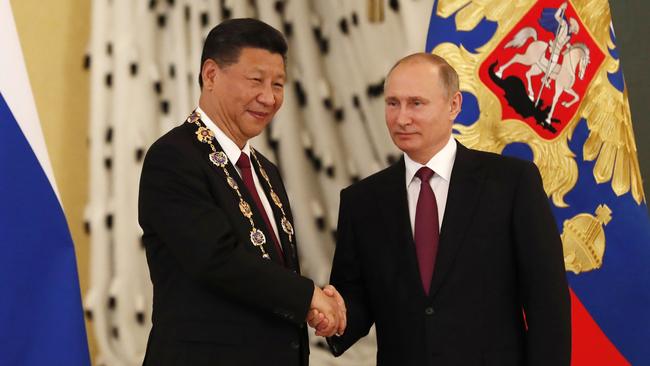China, Russia will soon be able to take out US satellites, Pentagon says
A REPORT has raised renewed concerns around Beijing and Moscow’s space capabilities — and how they could have major ramifications for Australia.
CHINA and Russia are developing anti-satellite missiles that could take down United States objects orbiting low Earth in as little as two years, the Pentagon has warned.
The Joint Staff intelligence directorate, or J-2, warned in an internal report that the two rivals are developing technology which could destroy and disrupt US satellites.
The report concludes that “China and Russia will be capable of severely disrupting or destroying US satellites in low-Earth orbit” in the next several years, officials close to the report told the conservative politics website Washington Free Beacon.
This capability could be in place as early as 2020, officials said.
The warning represents a huge concern to the US and follows one given in May last year by Director of National Intelligence Dan Coats. Mr Coats said Russia and China were “increasingly considering attacks against satellite systems as part of their future warfare doctrine”.
Concerns over Moscow and Beijing’s military capabilities and ambitions have been growing in recent times. Just days ago, US Defence Secretary Jim Mattis identified countering China’s rapidly expanding military and an increasingly aggressive Russia as America’s top national security priorities when he released a new strategy.
The US defence strategy warned China and Russia were a bigger threat to national security than Islamic extremism.

That view was apparently backed by Canberra when Defence Minister Marise Payne told The Australian: “It is for the US to determine what is of concern in relation to its national security, but I would note that Australia shares similar concerns.”
However, Senator Payne later clarified her view.
“Australia doesn’t see a threat in the region and we certainly don’t see China as a threat,” she said.
In an address to China’s national congress last year, President Xi Jinping set out his time frame for the country to become a “global leader” with international influence.
Mr Xi said “it was time for his nation to transform itself into a mighty force” that could lead the entire world on political, economic, military and environmental issues.
‘GROWING CONCERN’
John Blaxland, Professor of International Security and Intelligence Studies and director of ANU’s Southeast Asia Institute told news.com.au concerns over Russia and China’s anti-satellite technology had been building for some time.
“The US Department of Defense is undoubtedly concerned,” Professor Blaxland said.
“That is because much of the precision and geolocation technology, on which much of US military technology depends, is heavily reliant on maintaining their network of satellites unhindered by the prospect of anti-satellite (ASAT) strikes from China or Russia.”
Professor Blaxland said the ASAT concerns had driven the development of countermeasures, including a range of other geolocational tools not dependent directly on satellite systems such as the GPS satellite constellation.
Any attack on US systems would have huge ramifications for Australia.
“For Australia the concerns are very real as well, for even if we were not to be directly involved in a conflict that might erupt between the USA and China and or Russia, many of the systems on which Australian technological mastery depends, could be significantly degraded by such attacks,” he said.
“In essence, this points to Australia being heavily invested in the dominance of US military technology.
“It is with this in mind that the Department of Defence and other elements of Australia’s national security apparatuses are so committed to maintaining close ties and interoperability with the United States, helping to bolster redundancy and the capability edge.
“Indeed, despite much debate about where Australia might sit in a conflagration between the great powers, there is no question that it is strongly in Australia’s interests for US technology and military power to remain predominant.”
- with AAP



